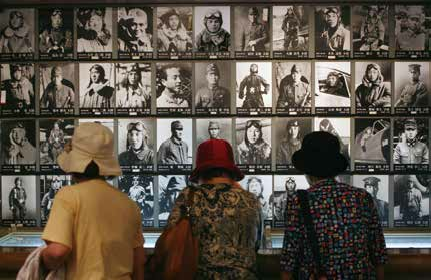Issue:
The Peace Museum for Kamikaze Pilots wants its collection of letters to be recognized by UNESCO

Shinao Hirayama, 91, speaks slowly as he recalls his youth as a kamikaze pilot some 70 years ago. Hailing from a Tokyo samurai family background, Hirayama says he eagerly volunteered to save his country from the jaws of the approaching American enemy. “Japan was losing the war at that time and so it was absolutely important for me to join the Tokkotai. I wanted to protect the country and the Emperor as I had been taught in school,” he explained.
Tokkotai is the abbreviation for Tokubetsu Kogekitai, literally “special attack unit,” but more usually referred to as the kamikaze, or “divine wind” suicide pilots. They were young, brave men who were sent on one-way flights at the tail end of World War II to swoop down on enemy ships with their bomb-laden planes to annihilate their targets and themselves.
Hirayama survived when Emperor Hirohito declared Japan’s surrender only a few days before he was due to board his plane. But that fate continues to upset him even today as he enjoys his retirement and grandchildren. “I wanted nothing more at that time than to be a human torpedo like the others,” he explained. The official number of kamikaze deaths on missions out of Chiran and other airfields during the Battle for Okinawa was 1,036. The wartime total was close to 4,000.
The fate of the young kamikaze pilots remains one of the most tragic stories of World War II. Courageous men as young as 17 were chosen by the Japanese military for their unflinching commitment to death. Indeed, much of the military’s loyalty was so fierce that even an admiral did a suicide dive with a tiny aircraft into the Allied fleet on the evening after Japan surrendered on Aug. 15, 1945.
“It would be too cruel not to show our respect to the unflinching spirit of these young men who were devoted to the Japanese people,” said Takeshi Kawatoko, a storyteller at the Peace Museum for Kamikaze Pilots located in Kagoshima on the southern island of Kyushu. The impressive building stores bone-chilling artifacts of Japan’s tortured past. It is nestled among the green hills of Chiran, where an airstrip was built for the Tokko tai to take off on their ill-fated flights to Okinawa in 1944. They were attempting to turn the tide of the bitter land battle being fought between desperate Japanese military forces and increasingly powerful American troops. Caught in the middle were the Okinawan civilians.
The museum displays more than a thousand letters written by the kamikaze along with models of the various planes some of their cockpits so narrow that pilots literally had to crouch with their knees bent almost to the chin. Among the somber exhibits are fading dolls and torn scarves that were once carried by the young men on their final journeys. Kawatoko explained how these items reflected the innocence and youth of the kamikaze: “They probably did not want to die alone,” he said. Indeed, their last letters, many penned in exquisite handwriting, include heart-wrenching passages. “Goodbye,” wrote 23-year-old Captain Toshio Anazawa to his sweetheart. “I have nothing more than wishes for your happiness.” “Forget the past,” Lieutenant Aihana Shoi wrote to his mother. “Live in the present.”
The emotions lingering from the kamikaze tactic, based on the traditional Japanese philosophy in which self-sacrifice can be used to turn the tide, are so powerful that visitors, around 700,000 annually, walk through the halls in hushed silence, some clutching handkerchiefs to their eyes. Kawatoko says the museum, supported by entry fees and the local government, is now attempting to register the last letters as UNESCO Memory of the World documents. They are, he says, “symbolic” of the country’s commitment to peace. “The registering of their messages as a world document is to recognize the pilots’ courage and Japan’s pledge to never enter a war again,” he said.
Such sentiment, however, is at the mercy of continuing political tension between Japan and its former East Asian colonies, China and the Korean peninsula, over its wartime past. And China, as expected, reacted to the request with indignation. “The design behind the socalled application for the kamikaze pilots is very clear, which is to try and beautify the Japanese militarist history of invasion,” Foreign Ministry spokeswoman Hua Chunying said.
“There is a kind of frustration because we dare not mourn our war dead in public for fear of an international outcry,” says Akiko Ozaki, 48, a tour guide for Chinese tourists. In fact, for Hirayama, who meets with the fellow former Tokkotai colleagues at the museum for its annual memorial every May, the pilots simply represent tragedy and courage. “We are a symbol of a national yearning for world recognition,” he says.
At the museum, Kawatoko says the pilots of the suicide flights represent the “Japanese samurai traits of putting loyalty over personal needs, a character that was deeply embedded in the national psyche but has been forgotten by the postwar generation.”
Leaving the haunting museum, one feels that the final rest due to the young suicide bombers is still a long way off as Japan and its East Asian neighbors grapple with the difficult past.
The kamikaze are waiting.
Suvendrini Kakuchi is a Sri Lankan reporter for Inter Press Service, and a regular commentator for Japanese publications and television.

